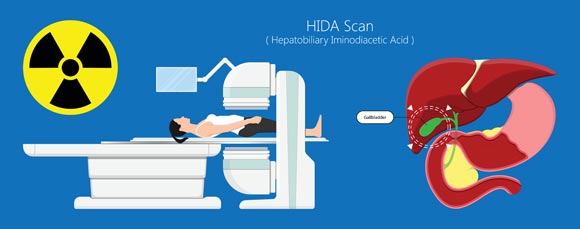How a HIDA Scan Can Help Your Overall Health Diagnosis
By Space Coast Daily // August 14, 2019
Detects Inflammation in the Gallbladder

A HIDA scan is an imaging scan that allows medical professionals to view the state of your small intestine, gallbladder, bile ducts, and liver. It’s a necessary procedure that is often used to evaluate the function of your gallbladder.
In this article, we walk you through the various ways a HIDA scan can help with your health diagnosis and ensure the proper function of your body.
The Importance of a HIDA Scan
A HIDA Scan, also called hepatobiliary scintigraphy or cholescintigraphy, stands for hepatobiliary iminodiacetic acid scan, and it is done to make sure that your gallbladder is working correctly.
It takes a look at how your liver produces bile and how the bile travels towards your small intestine.
It is a simple procedure where a radioactive tracer is injected through a blood vessel in your arm and makes its way through your liver where cells that produce bile pick it up. T
his tracer is then absorbed by bile as it makes its way to your gall bladder and small intestine. There are a few cases where a second procedure is necessary if the images taken by your doctor aren’t satisfactory.
Here are the following ways a HIDA scan can help with your overall health diagnosis:
Detects Inflammation in the Gallbladder
The gallbladder is responsible for the production of bile, and the tracer in the HIDA scan is picked up by cells that produce bile. This allows the HIDA scan to be a great way to diagnose potential gallbladder problems such as inflammation.
If the tracer is not detected, it could be indicative of inflammation or cholecystitis. Since gallbladder ejection fraction can also be measured by HIDA, you can also check for possible chronic inflammation or chronic cholecystitis if the levels are low.

Proper Determination of the Presence of Gallstones
Gallstones are formed from bilirubin and bile cholesterol. They are commonly known to be deposits of digestive fluids that harden in your gallbladder. Gallstones can cause intense pain in the upper right area of your abdomen, and this can pain also manifest in other areas of your body.
Upon the first symptoms of gallstones, your medical professional will advise you to go for a noninvasive ultrasound to attempt the detection of the presence of gallstones.
However, if none are found, a HIDA scan can be a secondary test that can check for blockages in the bile ducts and determine if you do have gallstones. Before undergoing the procedure, your doctor can advise you to also undergo a HIDA scan prep.
By observing the movement of the radioactive tracer used in the HIDA scans, your medical professional can tell a lot of things about the condition of your gallbladder and bile ducts. For example, the slow movement of a tracer could be a sign of a possible blockage potentially caused by gallstones.
Determine the Difference Between Neonatal Hepatitis and Biliary Atresia
In infants, a HIDA scan can distinguish between neonatal hepatitis and biliary atresia. Biliary atresia is a disease that can be treated using the Kasai procedure, but before it can be treated, it has to be distinguished from neonatal hepatitis.
The problem with these two birth issues is that they both have similar symptoms.
Being able to determine the differences at an earlier stage will help in the proper medical treatments that could potentially prolong the life of a child.
Help in Assessment of Liver Transplant
A liver transplant is a highly complex surgery that requires monitoring even after the procedure to check if the operation was successful. A HIDA scan can be used as one of the diagnostic tests to check for bile production and function of the liver.
If the liver is working correctly, then there shouldn’t be issues with the production and transportation of bile around the system.
Complications in Gallbladder Surgery
As in the case of a liver transplant, a HIDA scan can be used as a test after gallbladder surgery to determine if any problems come up. The production and transportation of bile are observed to check if proper functions have returned, but there is a small chance that there could be complications.
A complication that could arise is a bile leak, and this can be determined if the tracer used in the HIDA scan is detected in another area of your body.
Conclusion
A HIDA scan is a necessary procedure that can help determine the way your moves bile around. The great thing about it is that there are relatively minimal issues that arise from this procedure.
A patient that has undergone a HIDA scan can usually go about their day after the procedure is done. It is a necessary test to determine the proper function of your liver, gallbladder, and bile ducts. Treat your gallbladder, liver, and small intestine right. Do not postpone this test if you have to.
CLICK HERE FOR BREVARD COUNTY NEWS













